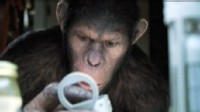Charles Darwin theorized how primates evolved. Charlton Heston played one in the original "Planet of the Apes." On Friday, the evolution of apes and movie-making will be showcased in "Rise of Planet of the Apes," the latest installment in one of the most profitable and longstanding franchises in Hollywood history.
The movie features a cast of simulated simians made possible by cutting-edge, computer-generated, visual arts technology, marking the beginning of a new stage in cinema.
Watch the full story, and see the new technology in action, on "Nightline" tonight at 11:35 p.m. ET
In the past -- as in the first "Planet of the Apes" -- make-up and prosthetics transformed actors into nonhuman characters. Then, it became something done totally in postproduction, with actors "acting" only with their voices.
The new technology uses something called a performance capture suit. It allows an actor to act as a real character, with computers storing each subtle move he makes.
"You have markers on your face which pick up, very subtly, your facial expressions," said Andy Serkis, who stars as the ape Caesar in the movie. "They track your eye movements, and you can perform very subtly for the camera as if it were as we are talking now.
'Rise of the Planet of the Apes' Computer Graphics Watch Video
The Digital Rise of the Apes Watch Video
Trailer: 'Rise of the Planet of the Apes' Watch Video
"It's like you're both puppeteer and puppet," he added, "and [when] you look into that monitor and you start to move, you can see the puppet moving. So it's like a magic mirror."
The absence of makeup and prosthetics means the acting becomes more natural.
"It's like being inside a video game," Serkis said. "You're literally connecting with an avatar on screen."
With this film, the technology is finally at a point where digital characters and the live action actors are physically together on the set for the big scenes. Never before have the actors actually been in the same room as their animated co-stars.
In other words, as this latest movie version of the "Planet of the Apes" story shows, the new technology allows acting to come to the foreground, where it belongs in movies.
"There really is a lot of fear about [the idea that] actors are going to be replaced by computer," Serkis said. "And it's the complete opposite. Here is a tool that enables you to play anything."
Serkis plays Caesar from infancy all the way to ape adulthood.
"It's an amazing role," Serkis said. "It's a huge arc. It goes from this innocent to Frankenstein's monster through to Che Guevara."
Thanks to his role as Gollum in the "Lord of the Rings" movies, Serkis has been called the Charlie Chaplin of performance capture, the master of a new craft of digital acting.
After years of acting in the United Kingdom, Serkis received a phone call that would change his career.
"So my agents called," he said. "It was, you know: 'They're doing this "Lord of the Rings" film down in New Zealand, and they're looking for someone to do a digital character's voice.' And I'm like, 'Well, there must be like a dozen decent roles in that movie. Can't you get me up for something proper?'"
Little did he know how much his career, and the industry, was about to change.
Before the performance capture suit, there was a technique called rotoscoping.
Joe Letteri, a visual-effects artist who worked with Serkis on "Lord of the Rings," described it: "We would just, frame-by-frame, just articulate our character to match his performance, because we had no other way to do it. So it was all done by hand, both for body and for the face."

 Andy Serkis in performance capture suit
Andy Serkis in performance capture suit


No comments:
Post a Comment